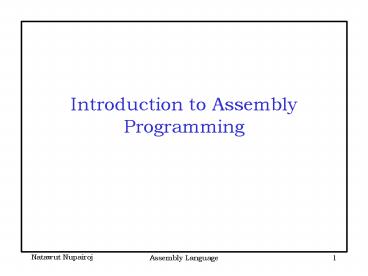Introduction to Assembly Programming - PowerPoint PPT Presentation
Title:
Introduction to Assembly Programming
Description:
Intel x86, Intel Pentium, etc. Reduce Instruction Set Computers (RISC) ... Intel Itanium (Pentium 4), Transmeta Crusoe. Pentium II/III/4 are special cases ... – PowerPoint PPT presentation
Number of Views:34
Avg rating:3.0/5.0
Title: Introduction to Assembly Programming
1
Introduction to Assembly Programming
2
Outline
- What is assembly ?
- How does it look like ?
- Type of instructions.
- Assembler and other tools.
3
What is Assembly ?
- Symbolic representation of machine language.
- opcodes
- operands
- labels
- More readable to human (not computer).
- add A, B 1000111000010110
- Easy to translate to machine language.
4
Level of Languages
- swap(int v, int k)
- int temp
- temp vk
- vk vk1
- vk1 temp
- swap
- muli 2, 5, 4
- add 2, 4, 2
- lw 15, 0(2)
- ...
- High level C / Java / Pascal
- Low level Assembly / Bytecode
- Machine Language
C Compiler
- 000010001101101100110000
- 000010001101101100110000
- 000010001101101100110000
- 000010001101101100110000
- ...
Assembler
5
When to Use Assembly
- When speed and size matter !
- Equipment that must response very quickly.
- Embedded devices.
- Device driver.
- When the resource is limited.
- When we use the specialized instructions
- 3D graphic library
- When there is no compiler !
6
When to Use Assembly
- When you want to understand internal architecture
of a CPU ! - Complex Instruction Set Computers (CISC)
- Intel x86, Intel Pentium, etc.
- Reduce Instruction Set Computers (RISC)
- DEC Alpha, Sun SPARC, HP P/A, MIPS, Pentium
II/III/4, etc. - Very-Large Instruction Word (VLIW)
- Intel Itanium (Pentium 4), Transmeta Crusoe.
- Pentium II/III/4 are special cases
- Outside CICS, inside RISC.
7
Drawbacks of Assembly
- Machine-dependent
- must be rewritten on another computer
architecture. - not portable.
- Longer codes to write.
- Difficult to read and understand.
8
Inside Computer
9
Instruction Formats
- Different CPUs, different formats.
- Something in common
- opcode instruction
- What is the command ?
- Arithmetic
- Branch
- operand perform that command on ?
- What is the data ?
- registers
- memory
- constant
10
Example adding two numbers
- Sparc r2 r0 r1
- add r0, r1, r2
- MIPS s2 s0 s1
- add s2, s0, s1
- IBM 370 R1 R1 R2
- AR R1, R2
11
Instruction Formats (Cont)
- Limited number of operands per instruction
- r5 r1 8 - r2 r3
- add r1, 8, r1 ! r1 r1 8
- sub r1, r2, r1 ! r1 r1 - r2
- add r1, r3, r5 ! r5 r1 r3
12
Translation Process
- Assembler
- translate assembly to a binary code.
- check syntax.
- produce an object file (not executable).
- Linker
- combine one or more object files.
- resolve references to other object files /
libraries. - produce an executable program.
13
Translation Process (Cont)
Assembly Program
Object File
Libraries
Assembler
Object File
Linker
Object File
Executable File
14
Other Tools
- Debugger
- trace assembly program.
- run a program in a step-by-step fashion.
- can display values of memory and registers.
- Profiler
- estimate time that a program spends in each
subroutine. - find the one with the longest time, optimize it.































